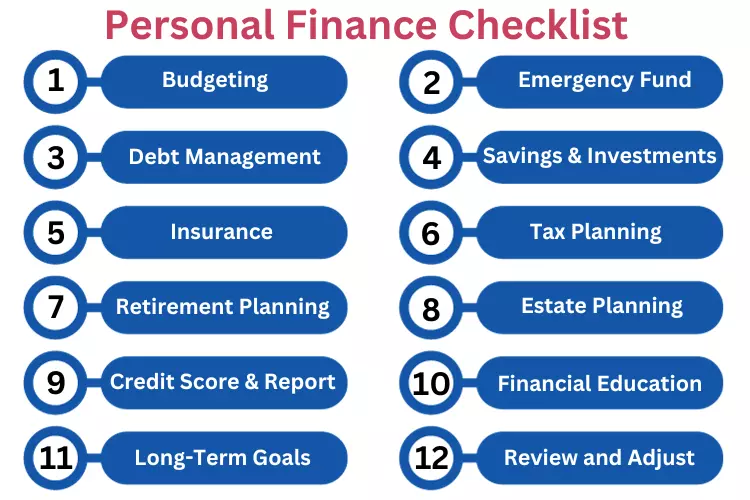Personal finance is a journey, and like any journey, it requires careful planning, organization, and regular check-ins to ensure you’re on the right track. A personal finance checklist serves as your roadmap to financial success, helping you make informed decisions, achieve your goals, and secure your financial future. In this article, we’ll delve into the essential components of a comprehensive personal finance checklist to empower you with the knowledge and tools to take control of your financial well-being.
12 Personal Finance Checklist
1. Budgeting
The foundation of sound financial management begins with budgeting. Creating a monthly budget allows you to understand where your money comes from and where it goes. Start by listing all your sources of income and categorize your expenses, including essentials like housing, utilities, groceries, transportation, and discretionary spending. Regularly tracking your spending against your budget is crucial to maintaining control over your finances. Make adjustments as needed to align your spending with your financial goals.
Let’s say you earn $4,000 per month after taxes. Your budget may look like this:
- Rent/mortgage: $1,200
- Utilities: $150
- Groceries: $300
- Transportation: $200
- Discretionary spending (dining out, entertainment): $250
- Savings (emergency fund, retirement): $500
- Debt repayment: $400
With this budget, you allocate specific amounts to each expense category, ensuring that your income covers your necessities, savings goals, and debt repayment.
2. Emergency Fund
Life is unpredictable, and unexpected expenses can arise at any moment. To safeguard your financial stability, establish and maintain an emergency fund. Aim to save at least 3-6 months’ worth of living expenses in a separate savings account. An emergency fund provides a financial safety net, allowing you to weather unexpected events like medical bills, car repairs, or job loss without resorting to debt.
Suppose your monthly living expenses are $2,500. You aim to save at least 3-6 months’ worth, which is $7,500 – $15,000. If you set aside $250 per month, it will take you 30 months (2.5 years) to reach your minimum emergency fund goal.
3. Debt Management
Debt can be a significant obstacle to financial well-being. List all your outstanding debts, including credit card balances, student loans, personal loans, and mortgages. Develop a debt repayment plan that prioritizes high-interest debts first. Consider using strategies like the debt snowball (paying off the smallest debt first) or the debt avalanche (paying off the highest interest debt first). Making consistent payments will help reduce and eventually eliminate your debts, freeing up more money for your financial goals.
Let’s say you have two outstanding debts: a credit card with a $5,000 balance at 18% interest and a student loan with a $10,000 balance at 5% interest. Using the debt avalanche method, you focus on paying off the credit card first because of its higher interest rate. By allocating an extra $200 per month to that debt, you could save over $2,000 in interest and pay it off faster.
4. Savings and Investments
Setting clear financial goals is essential to guide your savings and investment strategies. Whether you’re saving for retirement, a down payment on a house, education, or other objectives, having a specific target in mind helps you stay focused and motivated. Contribute to retirement accounts like a 401(k) or an Individual Retirement Account (IRA) and take advantage of employer matches if available. Diversify your investments to manage risk, considering a mix of stocks, bonds, and other assets based on your risk tolerance and long-term goals.
If your goal is to save $500,000 for retirement in 25 years, and you start with $50,000, you’ll need to save approximately $14,000 per year. Investing in a diversified portfolio, which may include stocks, bonds, and mutual funds, can help your savings grow over time.
5. Insurance
Insurance is a crucial component of financial security. Regularly review your insurance coverage, including health, life, auto, and home insurance. Ensure you have adequate coverage to protect yourself and your assets from unexpected events. Keep your policies up to date to reflect changes in your life circumstances.
Imagine you’ve recently purchased a home. Review your homeowner’s insurance to ensure it covers the full replacement cost of your house and its contents. In case of damage or theft, having adequate coverage can save you from significant financial losses.
6. Tax Planning
Understanding your tax obligations and opportunities is vital for optimizing your financial situation. Be aware of your tax filing deadlines and consider using tax-advantaged accounts and deductions. Health Savings Accounts (HSAs), Flexible Spending Accounts (FSAs), and retirement accounts offer valuable tax benefits. When necessary, consult with a tax professional to ensure you’re taking full advantage of tax-saving strategies.
Suppose you contribute the maximum allowable amount to your employer’s 401(k) plan, which is $19,500 for 2023. By doing so, you not only save for retirement but also reduce your taxable income. If you’re in the 22% tax bracket, this can result in $4,290 in tax savings for the year.
7. Retirement Planning
Planning for retirement is a long-term financial goal that requires careful consideration. Calculate how much you need to save for retirement based on your desired lifestyle in retirement. Maximize contributions to your retirement accounts and take advantage of employer matches if offered. Diversify your retirement investments to manage risk and adjust your strategy as you get closer to retirement age.
If you’re 30 years old and aim to retire at 65 with an annual income of $60,000 in today’s dollars, you’ll need to save and invest diligently. Assuming an average annual return of 6%, you’d need to save approximately $11,500 per year to reach your goal.
8. Estate Planning
Estate planning is not just for the wealthy; it’s a crucial aspect of responsible financial management. Create or update your will to specify how your assets should be distributed after your passing. Consider additional documents such as a living will, healthcare proxy, or power of attorney to outline your wishes regarding medical decisions and financial matters if you become incapacitated. Appoint beneficiaries for your financial accounts and insurance policies to ensure a smooth transfer of assets.
Imagine you want to ensure that your children receive your assets when you pass away. Creating a will that specifies your wishes can prevent confusion and legal battles among your heirs. You may also designate a trusted family member as the executor of your estate to carry out your wishes.
9. Credit Score and Report
Your credit score plays a significant role in your financial life. Regularly monitor your credit score and credit reports to stay informed about your credit health. Dispute any errors on your credit report promptly to maintain an accurate credit history. Building and maintaining good credit habits, such as paying bills on time and using credit responsibly, will help improve your credit score over time.
Suppose you notice an error on your credit report, such as an account mistakenly marked as delinquent. Dispute the error with the credit bureau promptly. Correcting such errors can improve your credit score, potentially saving you money on future loans or insurance premiums.
10. Financial Education
Financial literacy is an ongoing journey. Continuously educate yourself about personal finance topics by reading books, attending workshops, taking online courses, or seeking advice from financial experts. The more you know, the better equipped you’ll be to make informed financial decisions.
Enrolling in a financial literacy course or attending a free workshop can provide you with valuable insights. For instance, learning about investment strategies may help you make informed decisions about your retirement portfolio.
11. Long-Term Goals
In addition to short-term and intermediate financial goals, define your long-term objectives. Whether it’s early retirement, buying a second home, starting a business, or leaving a legacy, having a clear vision of your long-term goals will guide your financial planning efforts. Develop a detailed plan to work steadily toward these objectives over time.
Let’s say your long-term goal is to retire at 55 and travel extensively. You might create a plan that involves saving aggressively in your 401(k) and investing in a diverse portfolio to generate income during retirement.
12. Review and Adjust
A personal finance checklist is not a one-time exercise; it’s a dynamic tool that should evolve with your life circumstances and financial goals. Periodically review your entire checklist to ensure you’re making progress toward your objectives. Adjust your financial plan as needed to adapt to new goals and opportunities.
Periodically, you reassess your budget and discover that you’re consistently overspending on dining out. To get back on track, you decide to reduce your dining budget by $100 per month, allowing you to allocate that money to your emergency fund or debt repayment.
Conclusion
Your personal finance checklist is your compass on your financial journey. By diligently following these essential components, you can build a strong financial foundation, achieve your goals, and secure a prosperous future. Remember that personal finance is not a one-size-fits-all endeavor, so tailor your checklist to your unique circumstances and aspirations. With dedication and discipline, you can take control of your financial well-being and navigate the path to financial success.




